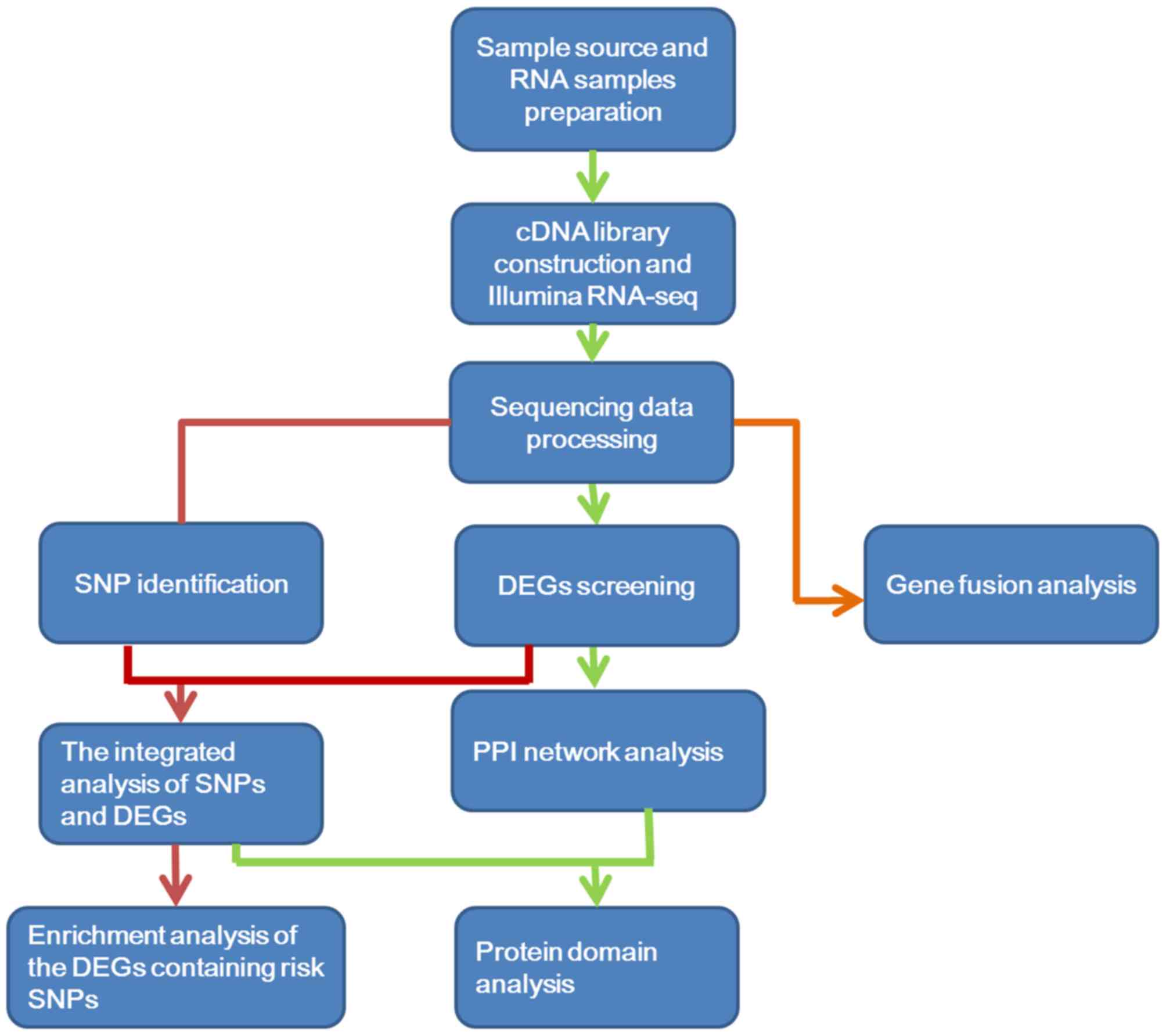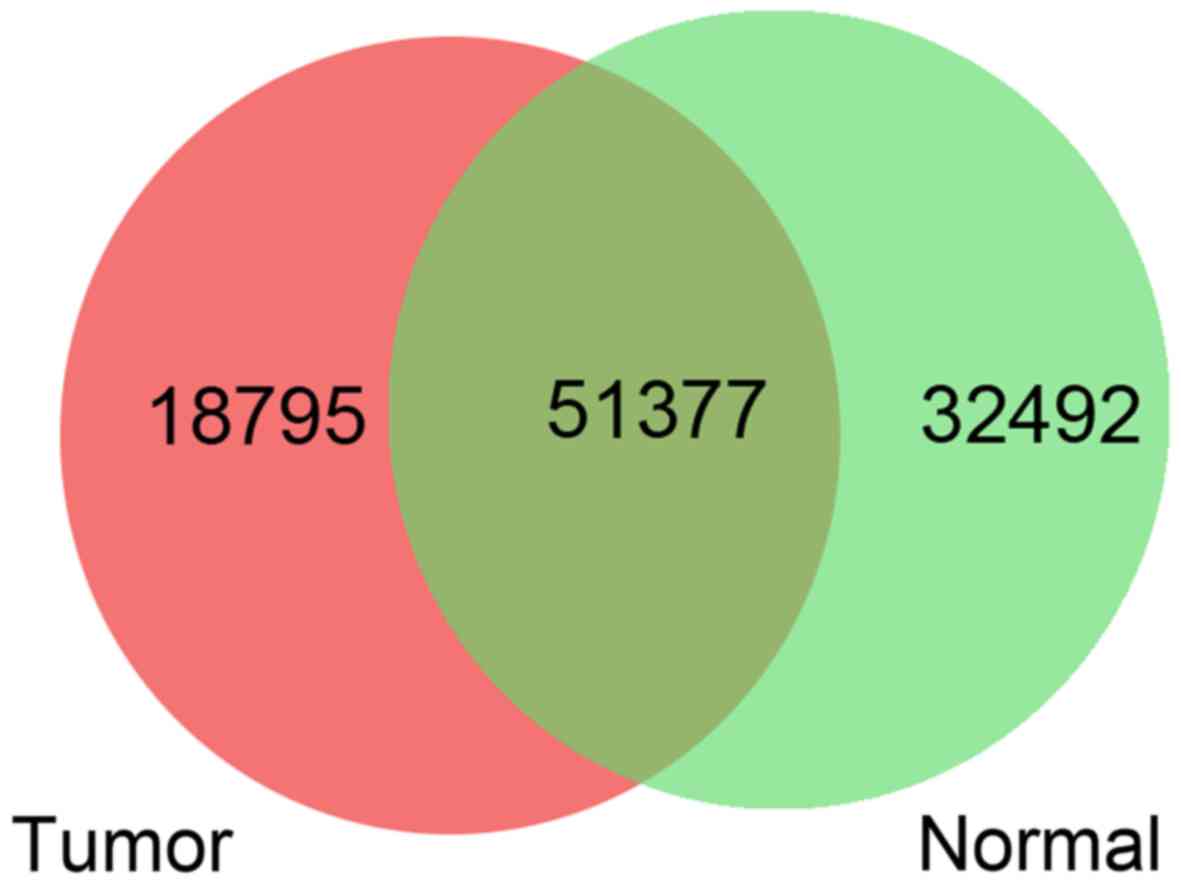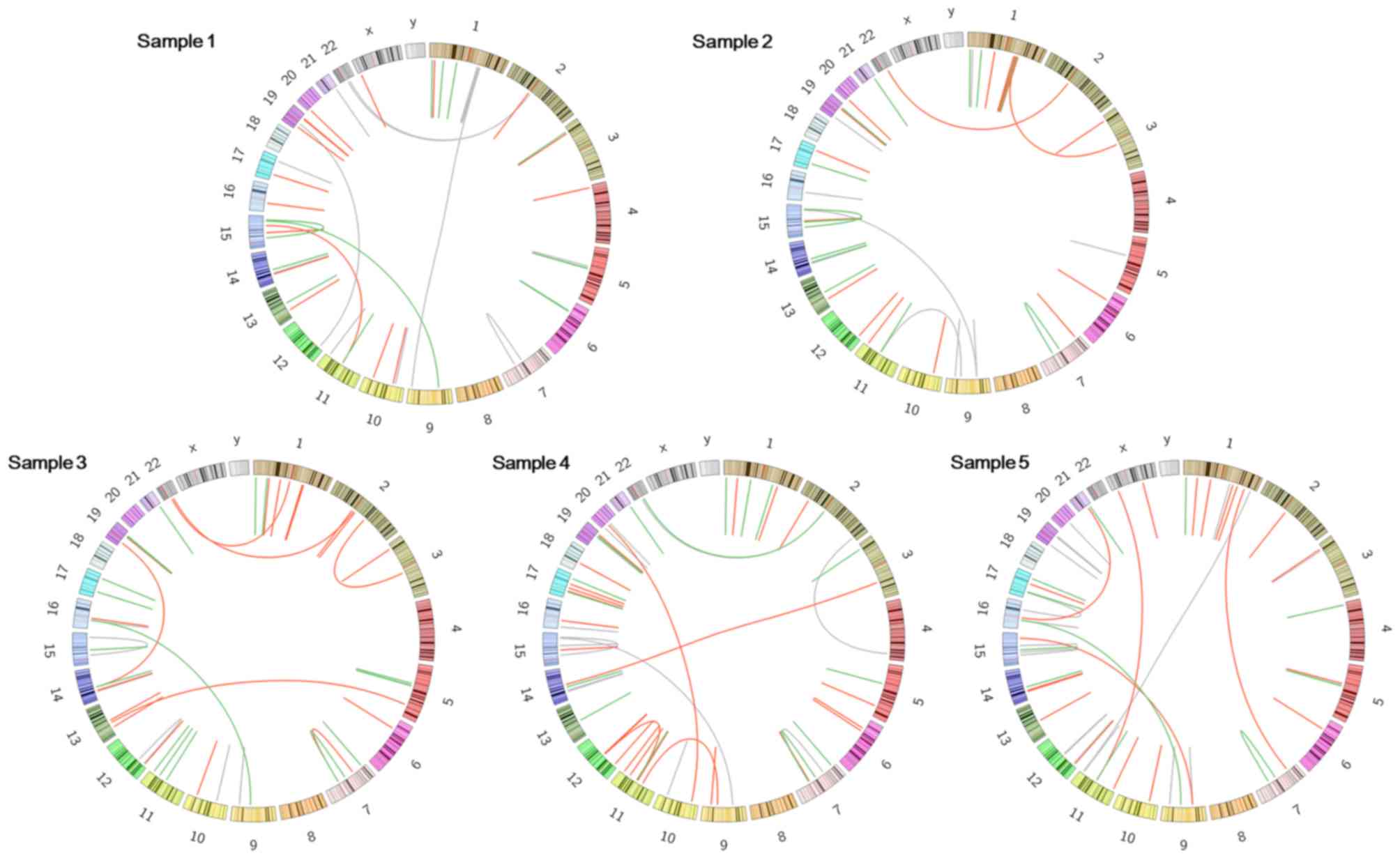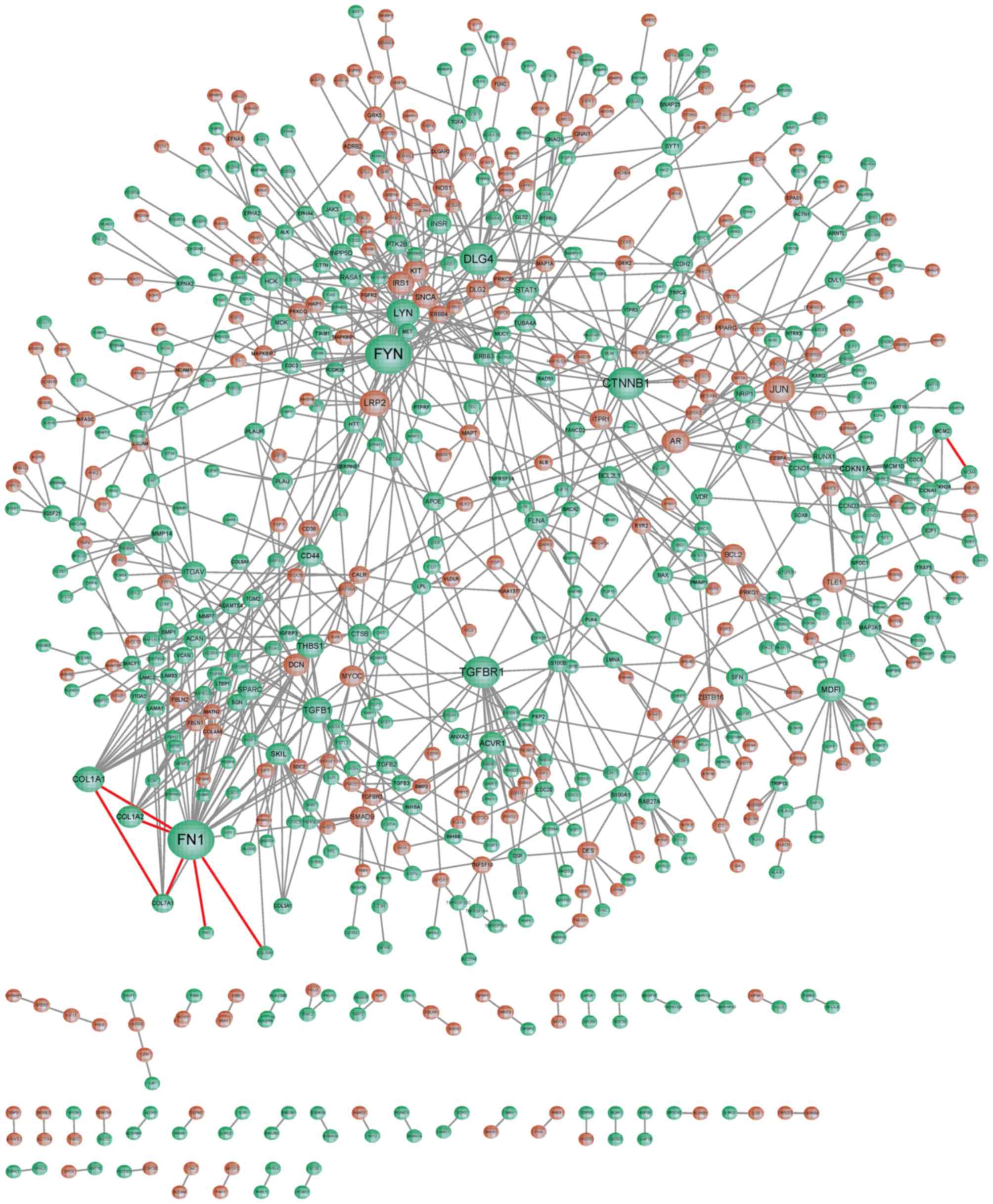|
1
|
Carling T and Udelsman R: Thyroid cancer.
Annu Rev Med. 65:125–137. 2014. View Article : Google Scholar : PubMed/NCBI
|
|
2
|
Vecchia CL, Malvezzi M, Bosetti C,
Garavello W, Bertuccio P, Levi F and Negri E: Thyroid cancer
mortality and incidence: A global overview. Int J Cancer.
136:2187–2195. 2015. View Article : Google Scholar : PubMed/NCBI
|
|
3
|
Dinets A, Hulchiy M, Sofiadis A, Ghaderi
M, Höög A, Larsson C and Zedenius J: Clinical, genetic, and
immunohistochemical characterization of 70 Ukrainian adult cases
with post-Chornobyl papillary thyroid carcinoma. Eur J Endocrinol.
166:1049–1060. 2012. View Article : Google Scholar : PubMed/NCBI
|
|
4
|
Mitchell RS, Kumar V, Abbas AK and Fausto
N: Robbins Basic Pathology. 8 edition. Philadelphia: Saunders; 8.
pp. 345–355. 2007
|
|
5
|
Xing M, Alzahrani AS, Carson KA, Shong YK,
Kim TY, Viola D, Elisei R, Bendlová B, Yip L, Mian C, et al:
Association between BRAF V600E mutation and recurrence of papillary
thyroid cancer. J Clin Oncol. 33:42–50. 2015. View Article : Google Scholar : PubMed/NCBI
|
|
6
|
Xing M, Liu R, Liu X, Murugan AK, Zhu G,
Zeiger MA, Pai S and Bishop J: BRAF V600E and TERT promoter
mutations cooperatively identify the most aggressive papillary
thyroid cancer with highest recurrence. J Clin Oncol. 32:2718–2726.
2014. View Article : Google Scholar : PubMed/NCBI
|
|
7
|
Lesueur F, Corbex M, McKay JD, Lima J,
Soares P, Griseri P, Burgess J, Ceccherini I, Landolfi S, Papotti
M, et al: Specific haplotypes of the RET proto-oncogene are
over-represented in patients with sporadic papillary thyroid
carcinoma. J Med Genet. 39:260–265. 2002. View Article : Google Scholar : PubMed/NCBI
|
|
8
|
Stephens LA, Powell NG, Grubb J, Jeremiah
SJ, Bethel JA, Demidchik EP, Bogdanova TI, Tronko MD and Thomas GA:
Investigation of loss of heterozygosity and SNP frequencies in the
RET gene in papillary thyroid carcinoma. Thyroid. 15:100–104. 2005.
View Article : Google Scholar : PubMed/NCBI
|
|
9
|
Salvatore G, Giannini R, Faviana P, Caleo
A, Migliaccio I, Fagin JA, Nikiforov YE, Troncone G, Palombini L,
Basolo F and Santoro M: Analysis of BRAF point mutation and RET/PTC
rearrangement refines the fine-needle aspiration diagnosis of
papillary thyroid carcinoma. J Clin Endocrinol Metab. 89:5175–5180.
2004. View Article : Google Scholar : PubMed/NCBI
|
|
10
|
Salajegheh A, Smith RA, Kasem K, Gopalan
V, Nassiri MR, William R and Lam AK: Single nucleotide
polymorphisms and mRNA expression of VEGF-A in papillary thyroid
carcinoma: Potential markers for aggressive phenotypes. Eur J Surg
Oncol. 37:93–99. 2011. View Article : Google Scholar : PubMed/NCBI
|
|
11
|
Ciampi R, Knauf JA, Kerler R, Gandhi M,
Zhu Z, Nikiforova MN, Rabes HM, Fagin JA and Nikiforov YE:
Oncogenic AKAP9-BRAF fusion is a novel mechanism of MAPK pathway
activation in thyroid cancer. J Clin Invest. 115:94–101. 2005.
View Article : Google Scholar : PubMed/NCBI
|
|
12
|
Wang X and Clark AG: Using next-generation
RNA sequencing to identify imprinted genes. Heredity (Edinb).
113:156–166. 2014. View Article : Google Scholar : PubMed/NCBI
|
|
13
|
de Klerk E, den Dunnen JT and 't Hoen PA:
RNA sequencing: From tag-based profiling to resolving complete
transcript structure. Cell Mol Life Sci. 71:3537–3551. 2014.
View Article : Google Scholar : PubMed/NCBI
|
|
14
|
Costa V, Esposito R, Ziviello C, Sepe R,
Bim LV, Cacciola NA, Decaussin-Petrucci M, Pallante P, Fusco A and
Ciccodicola A: New somatic mutations and WNK1-B4GALNT3 gene fusion
in papillary thyroid carcinoma. Oncotarget. 6:11242–11251. 2015.
View Article : Google Scholar : PubMed/NCBI
|
|
15
|
Smallridge RC, Chindris AM, Asmann YW,
Casler JD, Serie DJ, Reddi HV, Cradic KW, Rivera M, Grebe SK,
Necela BM, et al: RNA sequencing identifies multiple fusion
transcripts, differentially expressed genes, and reduced expression
of immune function genes in BRAF (V600E) mutant vs BRAF wild-type
papillary thyroid carcinoma. J Clin Endocrinol Metab. 99:E338–E347.
2014. View Article : Google Scholar : PubMed/NCBI
|
|
16
|
Abuín JM, Pichel JC, Pena TF and Amigo J:
BigBWA: Approaching the Burrows-Wheeler aligner to Big Data
technologies. Bioinformatics. 31:4003–4005. 2015.PubMed/NCBI
|
|
17
|
Li H, Handsaker B, Wysoker A, Fennell T,
Ruan J, Homer N, Marth G, Abecasis G and Durbin R: 1000 Genome
Project Data Processing Subgroup: The Sequence alignment/map (SAM)
format and SAMtools. Bioinformatics. 25:2078–2079. 2009. View Article : Google Scholar : PubMed/NCBI
|
|
18
|
Yang H and Wang K: Genomic variant
annotation and prioritization with ANNOVAR and wANNOVAR. Nat
Protoc. 10:1556–1566. 2015. View Article : Google Scholar : PubMed/NCBI
|
|
19
|
Robinson MD, McCarthy DJ and Smyth GK:
edgeR: A Bioconductor package for differential expression analysis
of digital gene expression data. Bioinformatics. 26:139–140. 2010.
View Article : Google Scholar : PubMed/NCBI
|
|
20
|
Park BJ, Lord D and Hart J: Bias
properties of Bayesian statistics in finite mixture of negative
binomial regression models in crash data analysis. Accid Anal Prev.
42:741–749. 2010. View Article : Google Scholar : PubMed/NCBI
|
|
21
|
Haynes W: Benjamini-Hochberg
MethodEncyclopedia of Systems Biology. Springer; pp. 78. 2013,
View Article : Google Scholar
|
|
22
|
Ge H, Liu K, Juan T, Fang F, Newman M and
Hoeck W: FusionMap: Detecting fusion genes from next-generation
sequencing data at base-pair resolution. Bioinformatics.
27:1922–1928. 2011. View Article : Google Scholar : PubMed/NCBI
|
|
23
|
An J, Lai J, Sajjanhar A, Batra J, Wang C
and Nelson CC: J-Circos: An interactive Circos plotter.
Bioinformatics. 31:1463–1465. 2015. View Article : Google Scholar : PubMed/NCBI
|
|
24
|
Tweedie S, Ashburner M, Falls K, Leyland
P, McQuilton P, Marygold S, Millburn G, Osumi-Sutherland D,
Schroeder A, Seal R, et al: FlyBase: Enhancing Drosophila gene
ontology annotations. Nucleic Acids Res. 37(Database issue):
D555–D559. 2009. View Article : Google Scholar : PubMed/NCBI
|
|
25
|
Kotera M, Moriya Y, Tokimatsu T, Kanehisa
M and Goto S: KEGG and GenomeNet, New Developments, Metagenomic
AnalysisEncyclopedia of Metagenomics. Nelson KE: Springer; New
York, NY: pp. 329–339. 2015
|
|
26
|
Dennis G Jr, Sherman BT, Hosack DA, Yang
J, Gao W, Lane HC and Lempicki RA: DAVID: Database for annotation,
visualization, and integrated discovery. Genome Biol. 4:P32003.
View Article : Google Scholar : PubMed/NCBI
|
|
27
|
Goel R, Harsha HC, Pandey A and Prasad
TSK: Human Protein Reference Database and Human Proteinpedia as
resources for phosphoproteome analysis. Mol Biosyst. 8:453–463.
2012. View Article : Google Scholar : PubMed/NCBI
|
|
28
|
Kohl M, Wiese S and Warscheid B:
Cytoscape: Software for visualization and analysis of biological
networks. Methods Mol Biol. 696:291–303. 2011. View Article : Google Scholar : PubMed/NCBI
|
|
29
|
Finn RD, Coggill P, Eberhardt RY, Eddy SR,
Mistry J, Mitchell AL, Potter SC, Punta M, Qureshi M,
Sangrador-Vegas A, et al: The Pfam protein families database:
Towards a more sustainable future. Nucleic Acids Res. 44:D279–D285.
2016. View Article : Google Scholar : PubMed/NCBI
|
|
30
|
Yellaboina S, Tasneem A, Zaykin DV,
Raghavachari B and Jothi R: DOMINE: A comprehensive collection of
known and predicted domain-domain interactions. Nucleic Acids Res.
39(Database issue): D730–D735. 2011. View Article : Google Scholar : PubMed/NCBI
|
|
31
|
Ma S, Wang Q, Ma X, Wu L, Guo F, Ji H, Liu
F, Zhao Y and Qin G: FoxP3 in papillary thyroid carcinoma induces
NIS repression through activation of the TGF-β1/Smad signaling
pathway. Tumor Biol. 120:34–35. 2016.
|
|
32
|
Zhang J, Wang Y, Li D and Jing S: Notch
and TGF-β/Smad3 pathways are involved in the interaction between
cancer cells and cancer-associated fibroblasts in papillary thyroid
carcinoma. Tumor Biol. 35:379–385. 2014. View Article : Google Scholar
|
|
33
|
Choe BK, Kim SK, Park HJ, Park HK, Kwon
KH, Lim SH and Yim SV: Polymorphisms of TGFBR2 contribute to the
progression of papillary thyroid carcinoma. Mol Cellular Toxicol.
8:1–8. 2012. View Article : Google Scholar
|
|
34
|
Prasad ML, Pellegata NS, Huang Y, Nagaraja
HN, de la Chapelle A and Kloos RT: Galectin-3, fibronectin-1,
CITED-1, HBME1 and cytokeratin-19 immunohistochemistry is useful
for the differential diagnosis of thyroid tumors. Mod Pathol.
18:48–57. 2005. View Article : Google Scholar : PubMed/NCBI
|
|
35
|
da Silveira Mitteldorf CA, de
Sousa-Canavez JM, Leite KR, Massumoto C and Camara-Lopes LH: FN1,
GALE, MET and QPCT overexpression in papillary thyroid carcinoma:
Molecular analysis using frozen tissue and routine fine-needle
aspiration biopsy samples. Diagn Cytopathol. 39:556–561. 2011.
View Article : Google Scholar : PubMed/NCBI
|
|
36
|
Tseleni-Balafouta S, Gakiopoulou H,
Fanourakis G, Voutsinas G, Balafoutas D and Patsouris E: Tenascin-C
protein expression and mRNA splice variants in thyroid carcinoma.
Exp Mol Pathol. 80:177–182. 2006. View Article : Google Scholar : PubMed/NCBI
|
|
37
|
Matsuse M, Takahashi M, Mitsutake N,
Nishihara E, Hirokawa M, Kawaguchi T, Rogounovitch T, Saenko V,
Bychkov A, Suzuki K, et al: The FOXE1 and NKX2-1 loci are
associated with susceptibility to papillary thyroid carcinoma in
the Japanese population. J Med Genet. 48:645–648. 2011. View Article : Google Scholar : PubMed/NCBI
|
|
38
|
Ngan ES, Lang BH, Liu T, Shum CK, So MT,
Lau DK, Leon TY, Cherny SS, Tsai SY, Lo CY, et al: A germline
mutation (A339V) in thyroid transcription factor-1 (TITF-1/NKX2. 1)
in patients with multinodular goiter and papillary thyroid
carcinoma. J Natl Cancer Inst. 101:162–175. 2009. View Article : Google Scholar : PubMed/NCBI
|
|
39
|
Gilbert-Sirieix M, Makoukji J, Kimura S,
Talbot M, Caillou B, Massaad C and Massaad-Massade L: Wnt/β-catenin
signaling pathway is a direct enhancer of thyroid transcription
factor-1 in human papillary thyroid carcinoma cells. PLoS One.
6:e222802011. View Article : Google Scholar : PubMed/NCBI
|
|
40
|
Ambroziak M, Pachucki J,
Stachlewska-Nasfeter E, Nauman J and Nauman A: Disturbed expression
of type 1 and type 2 iodothyronine deiodinase as well as
titf1/nkx2-1 and pax-8 transcription factor genes in papillary
thyroid cancer. Thyroid. 15:1137–1146. 2005. View Article : Google Scholar : PubMed/NCBI
|
|
41
|
Kondo T, Nakazawa T, Ma D, Niu D,
Mochizuki K, Kawasaki T, Nakamura N, Yamane T, Kobayashi M and
Katoh R: Epigenetic silencing of TTF-1/NKX2-1 through DNA
hypermethylation and histone H3 modulation in thyroid carcinomas.
Lab Invest. 89:791–799. 2009. View Article : Google Scholar : PubMed/NCBI
|














